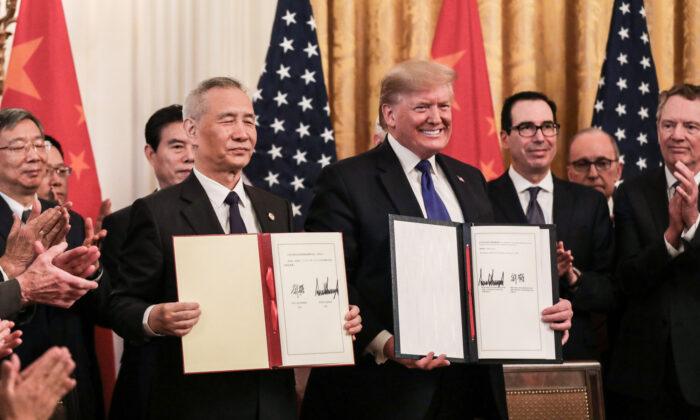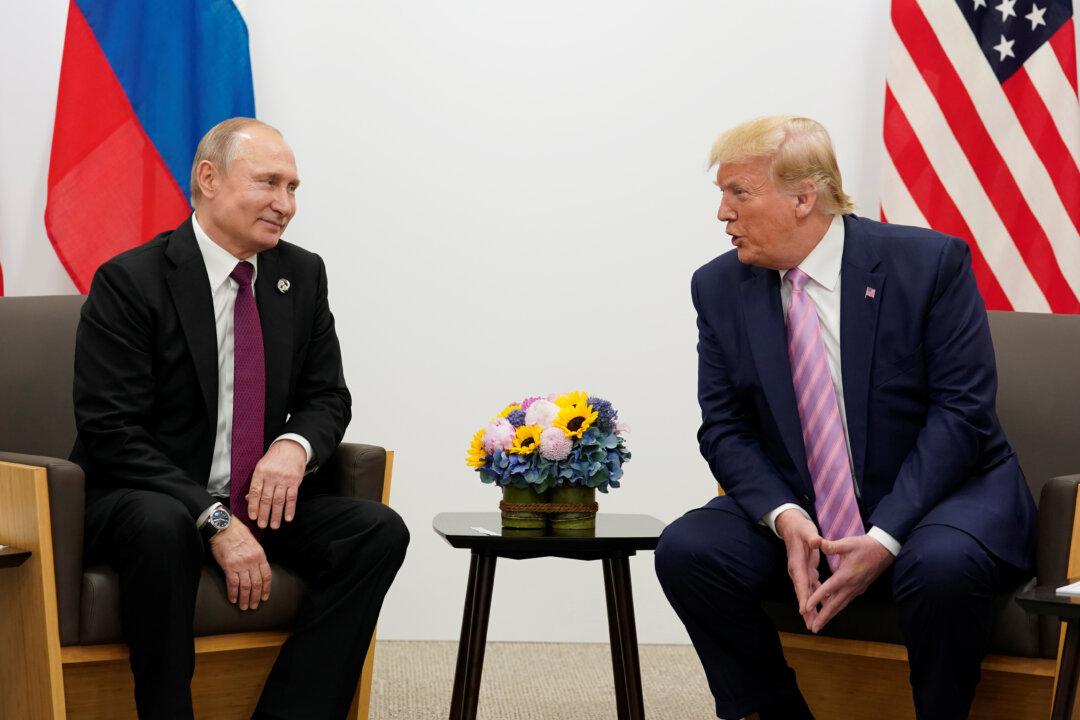Commentary
President Donald Trump’s trade deal with China is dead.
Hailed as a good first step when it was signed on Jan. 15, the phase one trade agreement was more about posturing than purchasing. Still, as we know, much has transpired since then that has made it difficult to imagine Beijing honoring its U.S. import quotas in the deal.
A Deal No One Could Refuse?
The phase one deal called for China to buy $200 billion worth of U.S. goods and services over the next two years. That’s compared to $186 billion worth bought by China in 2017.The deal also called for China to purchase another $77 billion in manufacturing goods over 2020–21, for what would have been about a $33 billion increase in U.S. exports to China this year, and about a $45 billion rise next year. Energy buys were to rise to more than $52 billion in 2020 from a $9.1 billion baseline in 2017.
Just as importantly, the phase one deal required China to follow through on
earlier promises to stem forced technology transfers and targeting U.S. firms for intellectual property theft. Those two activities have been the lifeblood of China’s technological sector growth and innovation. Beijing also agreed to refrain from currency manipulation and cut its 25 percent retaliatory tariffs on American cars.
For its part, the United States was to lower tariffs by half, to
7.5 percent, on $120 billion worth of Chinese goods and to suspend tariffs on Chinese cellphones, laptop computers, toys, and clothing.
Making Beijing promise to fulfill its earlier promises should have been a red flag, so to speak, for U.S. negotiators.
No Surprises
In the first week of June, to no one’s surprise, Beijing
broke the phase one agreement by ordering state-owned enterprises to cancel plans to buy U.S. soybeans, which were part of the $200 billion in U.S. products.
In reality, phase one was
never really a solid deal. It was full of empty promises that few believed would actually come about. The goals were lofty and unrealistic in the best of times. The world is now in very different economic and diplomatic conditions than it was when the deal was signed just five months ago.
In any case, it was more of a face-saving gesture for both sides and a basis, however minimal, from which to conduct future negotiations. But the deal was over before it ever got started.
Events and Actions Overshadow Trade
The CCP virus pandemic and ensuing lockdowns have crippled economies around the world and raised tensions with Washington. Beijing’s deceptive pronouncements and actions surrounding the pathogen were as damaging to the world as they were inexcusable—from denying its origins and human-to-human transmission capabilities, to allowing infected citizens to travel abroad while imposing domestic travel restrictions, and other actions.Then, with sweeping new
sedition laws aimed at the democracy protesters in Hong Kong, the Chinese Communist Party (CCP) has effectively subjugated the once autonomous city that is Asia’s most dynamic financial center.
The U.S. response was predictable. In the wake of the new laws from Beijing, Secretary of State Mike Pompeo
suspended the special trade treatment it had granted Hong Kong back in 1997 as a separate entity from China. The United States may also
apply sanctions and other economic penalties against China and Hong Kong.
But China’s behavior goes much further than its absorption of Hong Kong. While the U.S. Navy has been dealing with CCP virus infections in its Pacific fleet, China has been claiming and
militarizing disputed islands in the South China Sea, conducting military maneuvers near Taiwan, and conducting mock battles in critical sea lanes.
What’s more, while the U.S. Navy was in quarantine for the CCP virus in Guam, China’s air force increased its harassment of U.S. military aircraft in the South China Sea.
Where Do US–China Relations Go From Here?
While global demand for China’s goods remains low, so does China’s domestic consumption. In addition, a growing second wave of the CCP virus, as well as rising outbreaks in the Southern Hemisphere, may well mean that China’s economic malaise could deepen. And, of course, the economic downturn in both the United States and China make cooperation more
difficult.
Clearly, Beijing is playing a different hand now than in 2019. If domestic propaganda and
diplomatic rhetoric targeted at Japan and Taiwan are an indication of Beijing’s intentions, it would appear that China is overtly challenging U.S. security guarantees in the Asia-Pacific region.
Beijing’s military escalation has been apparent for several years, and yet received
minimal pushback from the prior U.S. administration. It’s possible that Beijing applied its expectations from the Obama administration to the current one as well.
If so, that raises the risk of miscalculation on either side, but in particular, with China. Beijing isn’t about to give up what it’s gained in the South China Sea or from its ongoing actions in Hong Kong.
Nor can Beijing politically afford the continued existence of Taiwan. With its relatively liberal republican political system and its deep military ties to the United States, Taiwan represents a real alternative to the Chinese people, which
threatens the legitimacy of the Party.
This is an ongoing and very serious problem for the CCP, which spends more money on suppressing its people than it does on external defense.
The quick reaction from the Trump administration, however, does pose a dilemma for Beijing. Washington’s decision to send three aircraft carriers to the Pacific is an obvious and necessary response, but one to which China must also react.
In other words, military escalation in the region is underway, making direct military confrontation between the United States and China
more likely than it was before.
As for the future of U.S.–China trade, the current developments likely
undercut the potential for any meaningful trade agreement between the two in the near future. They will likely widen the existing diplomatic gulf.
Or perhaps they’re just exposing the wide gap between China’s goals and those of the United States that was already there.
James R. Gorrie is the author of “The China Crisis” (Wiley, 2013) and writes on his blog, TheBananaRepublican.com. He is based in Southern California. Views expressed in this article are opinions of the author and do not necessarily reflect the views of The Epoch Times.





